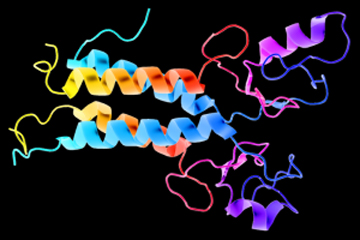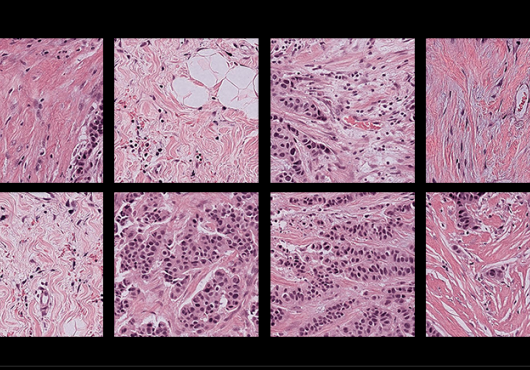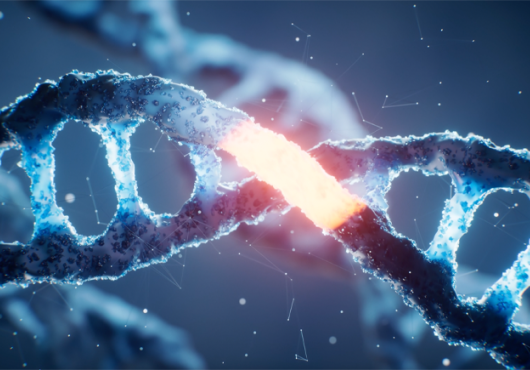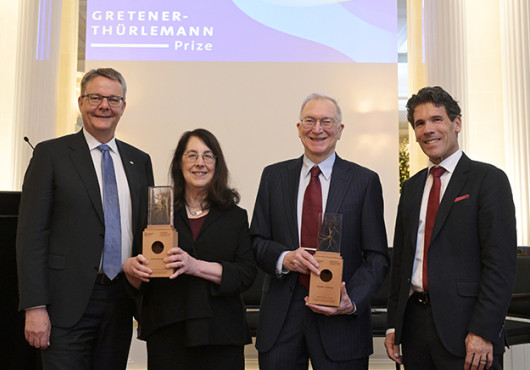Inherited mutations in the BRCA1 or BRCA2 tumor suppressor genes are by far the most frequent contributors to hereditary cancer risk in the human population, often causing breast or ovarian cancer in young women of child-bearing age. Attempts to test the role that the BRCA genes play in regulating a repair process associated with genome duplication have proven frustratingly difficult in living mammalian cells.
Now Harvard Medical School investigators at Beth Israel Deaconess Medical Center report a new mechanism by which BRCA gene loss may accelerate cancer-promoting chromosome rearrangements. The new findings explain how the loss of BRCA1 or BRCA2 function impairs homologous recombination, a normally accurate repair process used to fix DNA breaks, and actually stimulates faulty, error-prone homologous recombination repair.

Described online in the April 28 issue of Nature, the discovery could ultimately provide clinicians with valuable new information to help them ascertain risk and guide patient treatment when faced with BRCA mutations of uncertain significance. The finding also offers a potentially valuable new tool for the development of cancer therapeutics.
“Mutations in the BRCA genes cause breast and ovarian cancers that affect thousands of women throughout the U.S. and around the world, often striking them in the prime of life,” said senior author Ralph Scully, HMS associate professor of Medicine at Beth Israel Deaconess in the hospital’s Breast Cancer Oncology program. “For almost two decades, scientists have been striving to better understand the tumor suppressor functions of BRCA1 and BRCA2.”
Potentially harmful breaks in DNA strands commonly occur during DNA replication, a prerequisite for cell division. These breaks occur when the replication fork that duplicates the genome stalls at sites of DNA damage. If not properly repaired, the breaks can promote genomic instability, leading to cancer and other diseases.
“Some years ago, we and others suggested that BRCA1 and BRCA2 regulate homologous recombination at sites of stalled replication,” explains Scully. “We believe that this function is critical to how these genes suppress breast and ovarian cancer. Until now, we haven’t had the tools necessary to study in molecular detail the homologous recombination processes at sites of replication fork stalling in the chromosomes of a living mammalian cell.”
To solve this problem, first author Nicholas Willis, HMS research fellow in medicine in the Scully laboratory, created a new tool by harnessing a protein-DNA complex that evolved in bacteria.
“We found that the Escherichia coli Tus/Ter complex can be engineered to induce site-specific replication fork stalling and chromosomal homologous recombination in mouse cells,” explained Willis. “In its essence, E. coli bacteria—a standard model organism in science—has evolved a very simple system to arrest replication forks in a site-specific manner.”
This system is composed of short DNA elements called Ter sites, which are 21 to 23 base pairs long and tightly bound by the protein Tus. “Tus binds these Ter elements with extremely high affinity and, upon replication fork approach, acts as a barrier to fork progression along the DNA. Tus/Ter effectively sets up a ‘roadblock’ and stalls the replication fork.”
The acid test for the new tool, said the authors, came when this same short Ter sequence was placed into a reporter, a slightly larger DNA sequence that can undergo certain rearrangements within a chromosome when triggered to do so. “When it engaged in homologous recombination, a change in the sequence caused the cells to express green fluorescent protein,” said Willis. “When the cells glowed green, we knew we had a positive event.”
The team adapted the reporter sequence to distinguish between error-free/high-fidelity homologous recombination and an error-prone/aberrant form of homologous recombination. “Remarkably, when we studied cells lacking BRCA1 or BRCA2, we found that the frequency of aberrant homologous recombination events triggered at Tus/Ter-stalled replication forks had actually increased compared to normal cells. We knew at this point that we had discovered a new and important process by which BRCA gene loss promotes cancer.”
The discovery provides a promising bridge between basic science and the clinic, said Scully. “Sometimes a genetic sequencing test reveals a mutation in BRCA1 or BRCA2 that has not been definitively associated with cancer,” he said. Often described as “variants of uncertain significance,” these mutations are not found in high enough frequency in healthy women or in women with breast or ovarian cancers to allow the specific BRCA1 or BRCA2 mutations to be reliably classified as high risk or low risk. This is an important issue because a woman with a known high-risk BRCA gene mutation may elect to undergo potentially lifesaving prophylactic mastectomy or oophorectomy, Scully said.
“There is a growing appreciation that careful measurement of the homologous recombination functions of BRCA1 and BRCA2 variants-of-uncertain-significance mutants might help to classify them into high-risk or low-risk groups,” he said. “It would be gratifying if our system could contribute new information to help ongoing efforts to classify these mutants.”
Furthermore, understanding the mechanisms that regulate homologous recombination at stalled replication forks might hold additional promise for the development of novel cancer therapeutics. “If we could use this tool to help develop new cancer therapies, it would be a grand slam,” said Scully. “This new system might also be useful in genome editing, which is considered a groundbreaking technology used for the development of new gene therapies.”
This study was funded, in part, by National Institutes of Health grants R01CA095175, R01GM073894, R21CA144017, and R37GM26938; by National Institutes of Health /National Cancer Institute postdoctoral fellowship 5T32CA081156; and by ACS postdoctoral fellowship PF-12-248-01-DMC.
Adapted from a Beth Israel Deaconess news release.


